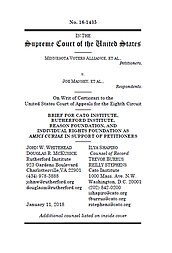We regret to inform you that, if you live in the state of Minnesota, you just broke the law. Minnesota prohibits any insignia deemed to be “political”—as determined solely at the discretion of the on-site election judges—from being worn into a polling place. When Minnesotans go to the polls, they may not convey to their fellow citizens that they are Republicans, or Democrats, or any “group with recognizable political views.” There is no requirement that the insignia encourage voting one way or another, or even relate to any candidate or issue on the ballot. Voters violate the law by wearing a hat or shirt bearing nothing more than the words “Occupy” or “Tea Party,” a picture of a blue donkey or red elephant, or a button explaining that they are a member of their union local—or that they “Like Ike.”
It’s hard to imagine a law more offensive to the First Amendment than a blanket ban on political expression by voters exercising their franchise—not speech by way of campaigning or soliciting or otherwise distracting or confusing voters, mind you, but just by wearing. Citizens are entitled to express their support for the causes they value by means of the press, and the soapbox, and their wallets, and, if they choose, their attire. Sartorial symbolism possesses a long pedigree in American discourse, be it black armbands to protest foreign wars, a gloved fist raised in defiance of racism, or a jacket vulgarly denouncing conscription.
But a polling place, Minnesota contends, is different, and the U.S. Court of Appeals for the Eighth Circuit agreed, holding that polling locations are a speech-free zone—a “non-public forum” in constitutional legalese—where the state may broadly prohibit anything as long as it doesn’t discriminate as to viewpoint. The Minnesota Voters Alliance disagrees, and the Supreme Court agreed to hear their case.
Cato, joined by the Rutherford Institute, Reason Foundation, and Individual Rights Foundation, filed a brief supporting the voters’ group, as we did at the petition stage. Our brief makes the point that what is referred to as “forum analysis”—a convoluted doctrine that treats a speech restriction differently depending on whether the courts deem it a “traditional public forum,” a “designated public forum,” a “limited public forum,” or a “nonpublic forum”—is irrelevant here. Instead of applying that judge-made doctrine rigidly, courts should always consider the underlying speech interests at stake. A complete ban on political expression should be met with the most searching judicial inquiry, regardless of the setting. While the Supreme Court has upheld limits on campaigning near polling stations, justified by the desire to ensure voters are not intimidated or bamboozled, these interests aren’t served by punishing any voter who shows up with a “Feel The Bern” button on their lapel. The Court should reaffirm that the First Amendment isn’t defined by real estate, and that other values matter beyond location, location, location.



